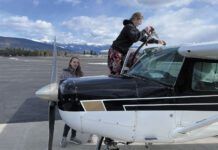Life keeps getting in the way of flying. We know that the best way to keep our skills and judgment level high is to fly frequently and take recurrent training every six months—just like the pros. But with seven-dollar avgas, we certainly aren’t flying nearly as frequently as we would like, and few of us schedule recurrent training more often than required by the FARs.

We know we should do more to keep our hands in—to fight the growth of aeronautical verdigris on our abilities. And, we’ve got our training manuals and DVDs we used to get our last rating, but those are not targeted at proficiency, are presented in lengthy segments and a lot of them can cure the worst case of insomnia.
What we do have are times when we can spare 20 minutes or a half hour to look at our tablet, iPhone or computer for brush-up sessions that are fast-paced, informative and interesting. That’s what Mark Robidoux and his team at PilotWorkshops.com realized when they developed the company’s line of products aimed at the pilot who wants to stay proficient but can’t set aside large chucks of time with regularity.
Starting in 2005, PilotWorkshops.com initially grew into a resource library of proficiency materials in audio and video formats that were presented by pilots with significant, specialized experience and the ability to communicate well. More recently it added two new products: a more interactive workshop series entitled IFR
Mastery as we’ll as a line of electronic and hard copy GPS manuals for Garmin and Bendix/King units.
We took a hard look at the PilotWorkshops.com product line and, overall, we liked what we saw. We think the offerings, especially the flagship IFR Mastery workshops, are a good way for a pilot to bolster his or her skill set between flights as we’ll as get more out of the time in the airplane.
IFR Mastery
Each month, subscribers to IFR Mastery get a new scenario involving a challenge on an IFR flight. We noted that the videos that set up the problems to be solved in each scenario were fast-paced and realistic. The user is given specific information regarding the type of airplane, pilot experience, route and weather, as we’ll as real-life conditions of weather, emotions and such things as where the cars are parked that affect pilot decision-making but are often ignored in more formulaic training courses.
In one, the experienced pilot has a relatively new IFR GPS and is using an iPad for charts, but doesn’t have a mount for it. She has her son, in the right seat, hold it. The links that can build into an accident chain are realistically snapped into place—ATC assigns a turn around a hold unexpectedly, the pilot misses one button push on the new GPS during the interruption on the approach, and then the son nudges the wrong spot on the iPad touchscreen and loses the approach plate. Inbound in the hold, the GPS display suddenly doesn’t make sense and you’re trying to get the plate back. Positional awareness at risk. Now what?
In the December 2013 scenario, based on a fatal accident, you are flying a FIKI-equipped Cessna 210 into the mountains of Oregon, part of the way into the GPS approach and getting a little bit of ice when you receive word on Unicom that there are snowplows on the runway and are asked to hold for a few minutes. Can you? Where? There be rocks nearby.
Still another scenario plausibly set us up to fly into the ground on a clear night when on a visual approach on an IFR flight plan.
We were surprised at how fast the creators of the scenarios can set up a very realistic, thought-provoking situation—the ones we viewed only took four to five minutes.
The end of each scenario offers four options to solve the problem presented. We’ve seen a lot of bad examples of multiple-choice exams over the years. The IFR Mastery series isn’t one of them. Most of the time the alternatives made plausible sense.
After viewing the scenario an options, your next step is to choose an option and vote. Once you choose, you see how every other viewer voted—we generally saw over a thousand votes cast by the time we’d looked at a scenario.
At this point you’ve probably only spent about six minutes and you’ve already pushed the boundaries of your IFR knowledge and judgment. Next, you watch a video by the creator of the scenario as he breaks down the flight, the options and why one is the best of the bunch. Again, the video is short, less than 10 minutes. Most were right on point, with no wasted time.
In 15 minutes you’ve gotten a good session on real-world IFR operations. You then have the option of going into a forum where you can exchange thoughts with PilotWorkshops.com instructors and customers, take a quiz on the underlying subject, and listen to a small group roundtable of the PilotWorkshops.com instructors dissect the scenario and admit that not all made the correct decision and why.
We generally liked the roundtables, although there were times that one of the instructors would start to pontificate or wander away from the subject. The roundtables run on the order of 15 minutes.
Once you’ve completed the workshop, another click takes you to the screen to obtain WINGS program credit for it—a nice little benefit, in our mind. Full time elapsed is about an hour—and the workshop is broken up so that you can do that hour in sections that are a maximum of about 15 minutes.
We like the scenario training—there wasn’t any of the goody-two-shoes-always cancel-if-there’s-a-cloud-in-the-sky approach taken by a lot of the training we’ve seen. The scenarios clearly recognize the financial and emotional issues faced by a pilot in the real world. “I can see the airport, I’m this close, I’ll land. It’ll be OK.”
Price is $19 per month and you can cancel at any time. The website says that the “$199 new member fee is waived.” As it stands, once you subscribe at $19, you get access to all back scenarios—a great deal, in our opinion. If we had to pay $199 to get in, we’re not sure we’d do so. However, at $19 per month, automatically billed, we suspect we’ll stay with it for at least a year, and have spent more than $199.
GPS Manuals
Another recent addition to the PilotWorkshops.com website is a collection of GPS manuals written for pilots by John Dittmer. The library covers most of the Garmin and Bendix/King line, both panel mount and handheld. Prices range from just below $40 to $55. While that seemed a little steep to us, it bought a hard copy and electronic version. We found that an electronic version on an iPad was a handy cockpit reference.
The manuals we looked at were we’ll written and broken up in a fashion that made sense for a pilot using the particular GPS. Most terms were clearly defined, something we appreciate. Because they are written in a how-to, or task-oriented style, we thought they were easier to use than the manufacturer’s manuals, although not always as thorough.
Aviation Weather
The PilotWorkshops.com aviation weather product consists of 63 modules averaging about 13 minutes long—although a number go we’ll over 20 minutes. They are in-depth and go into three overall subject areas: Beyond the Weather Brief, Terminal Forecasts—Reading Between the Lines, and More Weather Analysis and Online Tools.
Presented by Scott Dennstaedt, who has written for this magazine, the videos are paced we’ll and make liberal use of good-quality images of available weather information with clear explanations as to the why and how of the stuff we face when we launch our airplanes. There are times that there was so much information, we were grateful for the ability to back up and re-run a section.
We appreciated the extensive reference to resources available for preflight planning as we’ll as the effective use of XM weather while en route.
$139 gets you permanent online access to the modules, while $179 buys the online access as we’ll as a thumb drive with all 63 videos loaded.
Airmanship
The Airmanship series from PilotWorkshops.com consists of 26 video and 13 audio modules targeted at a pilot who wants to review fundamentals such as crosswind landings, ATC communications, stick-and-rudder skills, non-towered airport operations and emergency landings.
As with all of the PilotWorkshops.com instructional materials, the instructors teaching them are high time and communicate well. In our opinion, this is a good series for a pilot who wants a way to keep her or his VFR skills up.
Price is $159 for unlimited access and $199 for access plus a thumb drive loaded with all of the classes.
IFR Proficiency
The IFR Proficiency series from PilotWorkshops.com is designed to help a pilot improve his or her skills in all aspects of instrument flight—not prepare for a rating. The list of instructors who put together the 30 videos and 10 audio lessons is impressive (and too long to repeat here). All run on Windows and Mac computers, iPad and Android tablets and iPhones.
We found that we looked over the topics and viewed those in areas where we felt we were rusty. There are transcripts of each of the lessons.
We think the price is a little steep compared to the Aviation Weather material—unlimited Internet access to the modules is $199—access plus a thumb drive with the videos and audio lessons is $239. For us, looking at price, value, time and keeping things lively, we were more interested in the IFR Mastery product, although we recognize that the two products are separately targeted.
All of the PilotWorkshops.com programs are eligible for WINGS program credits. We are fans of the WINGS program and are pleased to see that the PilotWorkshops.com materials qualify. PilotWorkshops.com just announced that the FAA has just issued the 10,000th WINGS course completion credit for its customers who had completed its courses.
Conclusion
We spent several hours looking at videos, listening to audio programs and picking which action we would take when things started to go bad when IFR and came away confident that a pilot who wants to use the courses offered by PilotWorkshops.com to help keep his or her edge will be making a good choice. The products are useful recurrent training tools as we’ll as a long-term reference.





